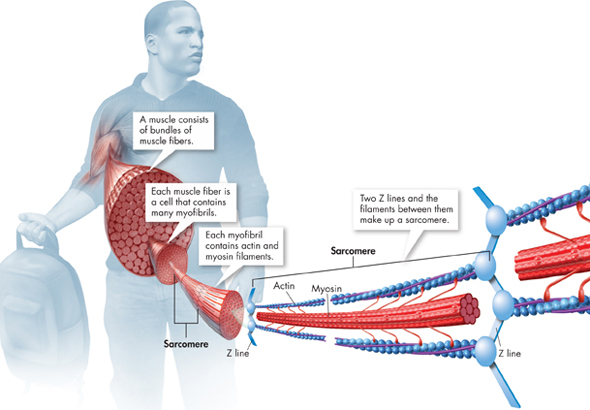Muscle Contraction
 How do muscles contract?
How do muscles contract?
Muscles produce movements by shortening, or contracting, from end to end. How do cells generate such force? The answer can be found in the way in which two kinds of muscle protein filaments interact.
BUILD Vocabulary
PREFIXES The prefix myo- in myofibril means “muscle.” The word comes from the Greek word for mouse. Artists and sculptors once thought well-developed muscles looked like mice under the skin.
Muscle Fiber Structure Skeletal muscle cells, or fibers, are filled with tightly packed filament bundles called myofibrils. Each myofibril contains thick filaments of a protein called myosin (MY uh sin) and thin filaments of a protein called actin. These filaments are arranged in an overlapping pattern that produces the stripes or striations so visible through a microscope. The thin actin filaments are bound together in areas called Z lines. Two Z lines and the filaments between them make up a unit called a sarcomere. Figure 32–7 shows the structure of a muscle fiber.
The Sliding-Filament Model Myosin and actin filaments are actually tiny force-producing engines.  During a muscle contraction, myosin filaments form cross-bridges with actin filaments. The cross-bridges then change shape, pulling the actin filaments toward the center of the sarcomere. As shown in Figure 32–8, this action decreases the distance between the Z lines, and the fiber shortens. Then the cross-bridge detaches from actin and repeats the cycle by binding to another site on the actin filament. As thick and thin filaments slide past each other, the fiber shortens. For this reason, the process is called the sliding-filament model of muscle contraction.
During a muscle contraction, myosin filaments form cross-bridges with actin filaments. The cross-bridges then change shape, pulling the actin filaments toward the center of the sarcomere. As shown in Figure 32–8, this action decreases the distance between the Z lines, and the fiber shortens. Then the cross-bridge detaches from actin and repeats the cycle by binding to another site on the actin filament. As thick and thin filaments slide past each other, the fiber shortens. For this reason, the process is called the sliding-filament model of muscle contraction.
When hundreds of thousands of myosin cross-bridges repeat these actions, the muscle fiber shortens with considerable force. Contractions like this enable you to run, lift weights, or even turn a page in a book. Because one molecule of ATP supplies just enough energy for one interaction between a myosin cross-bridge and an actin filament, a muscle cell needs plenty of ATP.
VISUAL SUMMARY
SKELETAL MUSCLE STRUCTURE

FIGURE 32–7 Skeletal muscles are made up of bundles of muscle fibers composed of myofibrils. Each myofibril contains actin and myosin filaments. Interpret Visuals What type of unit are actin and myosin filaments arranged in?
dTable of Contents
- Formulas and Equations
- Applying Formulas and Equations
- Mean, Median, and Mode
- Estimation
- Using Measurements in Calculations
- Effects of Measurement Errors
- Accuracy
- Precision
- Comparing Accuracy and Precision
- Significant Figures
- Calculating With Significant Figures
- Scientific Notation
- Calculating With Scientific Notation
- Dimensional Analysis
- Applying Dimensional Analysis




